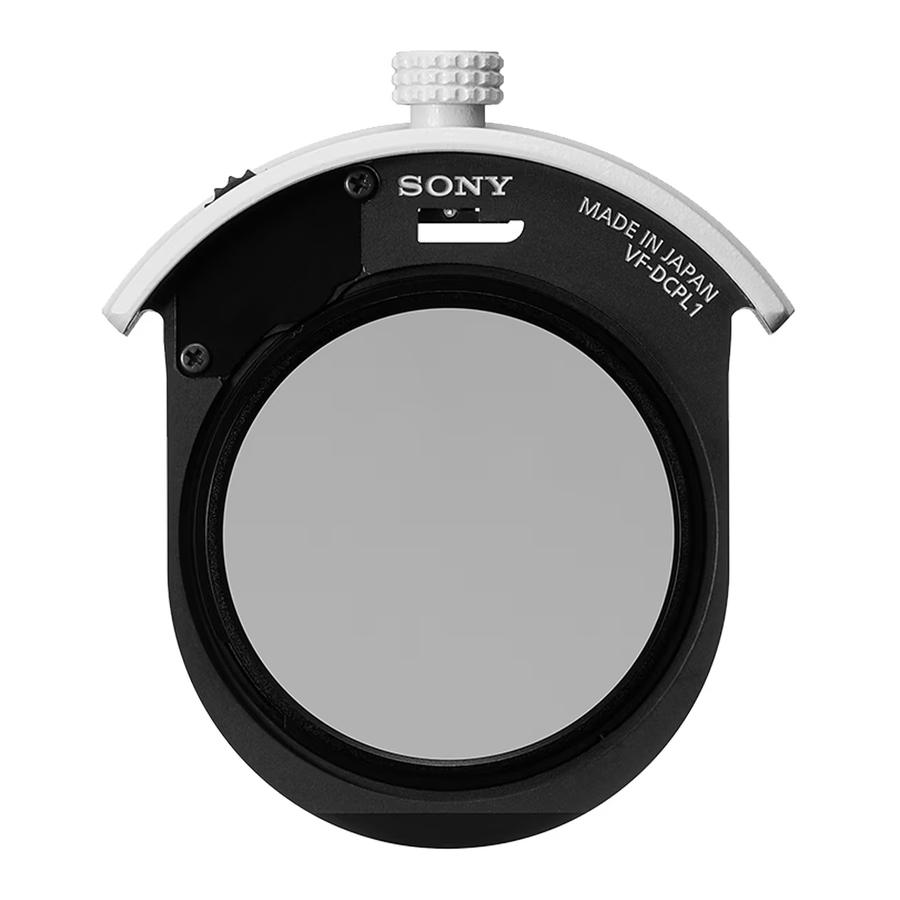Advertisement

Introduction
This instruction manual explains how to use filters. Precautions common to all filters such as notes on use are found in the separate "Precautions before using". Be sure to read both documents before using your filter.
This filter is designed for Sony α camera system E-mount lenses. You cannot use it on A-mount lenses.
For further information on compatibility, visit the web site of Sony in your area, or consult your dealer of Sony or local authorized service facility of Sony.
Notes on use
- This filter should be carefully stored in a place not subject to heat or in direct sunlight. It is sensitive to heat and ultra violet rays due to the coating process of the polarizing film between optical glasses.
- When you find this filter wet or soiled on its surface, wipe off with a soft, dry cloth.
- To open the filter case, rotate the top lid counterclockwise with the Sony logo facing upward. If you apply excessive force without rotating it, it may cause damage.
- The filter case is not intended to protect the filter from a strong impact, such as dropping. Take sufficient care of handling the filter.
Identifying the Parts

- Filter-holder knob
- Adjustment ring
Attaching this filter

- Insert the filter into the lens barrel with the flat cut-off surface of the filter-holder knob facing toward the lens front (1).
- Push down and turn the filter-holder knob clockwise by 90° to lock the filter (2).
- When the filter-holder knob is locked, the index bar on the flat cut-off surface of the filter-holder knob is aligned with the index bar on this filter (3). After replacement of the filter, make sure that the filter-holder knob is properly locked.
Using this filter

- Adjust the focus precisely while looking through the viewfinder, etc.
- Rotate the adjustment ring on this filter while looking through the viewfinder, etc., to adjust the polarization degree for photographing.
- This filter can reduce or eliminate unwanted reflections (polarized light) from nonmetallic surfaces of water, glass, windows, shiny plastics, ceramics, paper, etc. It also helps you get good contrast when taking photos of blue sky.
- Generally, reflected light (polarization) should be minimized in photography. However, you can adjust the polarizing degree for the desired effect as well.
- The amount of light reaching the image sensor decreases. If your camera is set to manual exposure mode and you are using a commercially available exposure meter, or if your camera is set to manual exposure mode and you are using the Manual Flash Control function available on some external flash units, adjust the exposure compensation by opening the aperture by 1 to 2 stops to the + side.
Specifications
| Model name | VF-DCPL1 |
| Dimensions (w/h/d) (approx., mm (in.)) | 55.7 × 63.3 × 15 (2 1/4 × 2 1/2 × 19/32) |
| Mass (approx., g (oz.)) | 30 (1.1) |
Included items
(The number in parentheses indicates the number of pieces.) Filter (1), Filter case (1), Set of printed documentation Designs and specifications are subject to change without notice.
 is a trademark of Sony Corporation.
is a trademark of Sony Corporation.

VideosWhat's a polarized filter and why do you need it? Video
Documents / ResourcesDownload manual
Here you can download full pdf version of manual, it may contain additional safety instructions, warranty information, FCC rules, etc.
Download SONY VF-DCPL1 - Drop-in Circular Polarizing Filter Manual
Advertisement
Thank you! Your question has been received!



















Need Assistance?
Do you have a question about the VF-DCPL1 that isn't answered in the manual? Leave your question here.